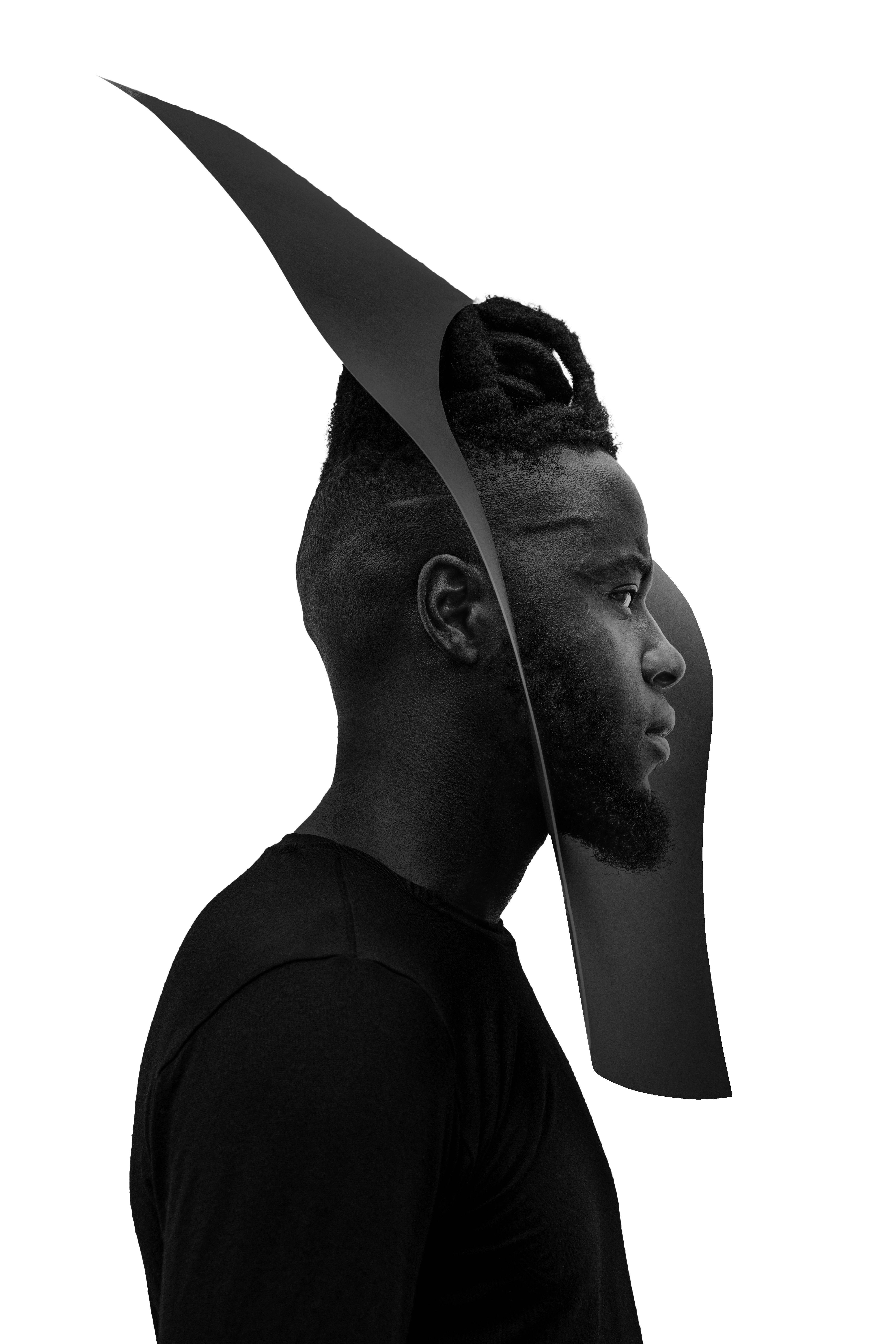Soweto born and raised photographer and filmmaker Justice Mukheli has an affinity for eyes. He expresses his relationship with them by saying “Eyes tell you a lot about a person before you even speak to them, when I create photographs or capture moments. I am mostly looking for emotions I have felt or emotions I am feeling in that moment. Eyes carry emotions and stories in depth. So, portraiture gives me the opportunity to capture my emotions and express them through other people’s eyes.”
Paper becomes art, framing his neck and head, accentuating features. A headpiece. A neckpiece. His eyes dominate each frame. A simple circle passes through his hair and around his face. He becomes elevated, face and neck gently cushioned; paper appearing with shadows of the most tantalizing seduction. He speaks to me with his eyes.
For Justice, photography came into his life through Advertising in 2011 where he worked as an Art Director for about 6 years. It was while working with South African brands, putting together campaigns for them that Justice recognised that the images that were being used were not of authentically South African people. This divide between brands and their target audience led him to the realization that consumers could not relate to these brands as they could not identify with these representations of ‘individuals’. Taking it upon himself to photograph some of the work for the campaigns he dealt with for presentations, his work later became of such stature that clients began to trust him with shooting their brand campaigns.
“While I was on my journey of reframing the face of some brands to their consumers, that process made me realize the importance of telling our own story and documenting ourselves. I am from Soweto, and Soweto is famously known for the uprising movement and the resistance during the apartheid times. As important as that part of history is about Soweto, it left somewhat a negative image to most. People think it’s dangerous there, they think Soweto is poor and it’s a dark place. So it became immediately important [to] me when this realization sunk in. I wanted to show the Soweto I grew up in, I wanted to show my personal experience of this beautiful and most amazing place. I wanted to capture love, happiness, pride, joy, dignity, beauty, soul and Authenticity.”

With a passion for the visual narration of authentic South African stories it is Justice’s intent to “inspire those without voices to speak and be heard” and to act as a motivation for others to tell their own truths from their personal perception. “Because by me simply being a guy who grew up in Soweto, I am relatable to many like me that didn’t have voices, so, through seeing me speak, they gain Confidence to speak too. Our narrative can only be true and powerful if it is written, captured and spoken for, by us, the people.”
Dissecting the message of his work it becomes clear that as the visual auteur has grown in his practice, his interest in masculinity has become more prominent. Recent projects become an endeavour to seek answers to the question of what being a man would look like if societal influence was not of consequence. “As a young boy and as a young man I was always told that ‘a man never cries, you are not allowed to be seen crying’, ‘A man’s word is always final’, ‘A man must never negotiate with a woman’. In my recent work I am questioning [and] engaging [with] what impact did what I grew up being told as a young boy by all the men around me have on me, on my EQ and IQ development? And in the process of engaging [with] all of this, I realized how much work we as men have to do…”
What strikes about Justice’s images is that it does not become rigid through a singular approach. It is evident that he is after emotion and a physical record of this emotion captured within the reflection of a human eye, the only physical indication we have of a soul. Depth of field fluctuates according to his photographed sitter. It could be esteemed that his choice of depth of field is also subject to his personal emotion captured through others. Some images contain deep contrast and evoke a sombre tone, some are more jovial and light. Though he is self-taught none of the typical characteristics of a self-trained eye are prevalent in his images and instead remind of careful curation and considered use of light. His images climb out of their two-dimensional frames and become more real than reality.
And how does he capture his vivid visualizations you might ask? Justice has a wide selection of cameras ranging from a Pentax 67ii with a 105mm f2.4 lens, to a Leica M7, to the Mamiya 67RB for commercial work and a Rolleiflex f2.8 for travelling.
However currently Justice’s main preoccupation is a focus on his directing career to which he applies the same principles as in his still imagery. With a motivation to inspire other young people to tell their stories from their personal perspectives, Justice’s work is honest and it is this honesty that makes his work authentic and emotional.
Credits:
Photography & Styling: Jamal Nxedlana





















































